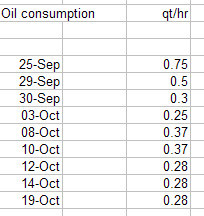Aviathor wrote:
It sounds extremely high to me. Have never seen more than 1 l in 10 hrs. On my trip to Norway past summer I flew in excess of 20 hrs and did not even add oil. It was 7 qt when I left and still above 6 qt upon my return. IO360 A1B1 (?)
It may seem high compared to 1 anecdotal example, but in fact is closer to “normal”, and still well under what the manufacturer calls excessive.
vic wrote:
I´d have expected you do your high flight level climbs at about 80 percent max revs as compared to 60 to 55 percent in cruise.
Ern he said NA, so even with the balls-to-the-wall, by 5,000’ feet your’ already under 80% power but only 1/8 of the total time to climb to FL200.
Very true; above FL180 is max revs always…
vic wrote:
I said 80 percent REVS, not power, meaning, at high revs you usually see higher oil burn than at cruise revs. just an idea …. Vic
OK, but the problem the OP is dealing with here is with cylinder rings and the problem at lower power or precisely low MP is the lack of cylinder pressure to seal the rings.
I am with Michael on this one. Also the majority of the climb time is at 60% power or less. How much time to climb to FL100 power 100%-60% ad how much Time from FL100-FL200 60% -40% power. It might be even less power. By the way what does you MP show at that altitiude Peter?
By the way till my #5 started burning oil I was getting 1qt/15 hrs That was for 850hrs of flying.
I have one more data point now, from yesterday’s 2.5hr flight

The apparent amazing consistency in the last few is of course due to the data being quantised due to reading the dipstick to the nearest 1mm  But it seems to be stable at 3.5hrs/quart which I am happy with and is probably largely in line with the recent historical level.
But it seems to be stable at 3.5hrs/quart which I am happy with and is probably largely in line with the recent historical level.
C210_Flyer wrote:
I am with Michael on this one. Also the majority of the climb time is at 60% power or less. How much time to climb to FL100 power 100%-60% ad how much Time from FL100-FL200 60% -40% power. It might be even less power. By the way what does you MP show at that altitiude Peter?
It’s a little bit higher. An NA engine at WOT gives you about 70% power at FL100 and should give you in the order of 45% at FL200.
Just for fun, I made a quick estimate of the average power for a one-hour climb to FL200, assuming a linear decrease in ROC with altitude. It would be about 60%.